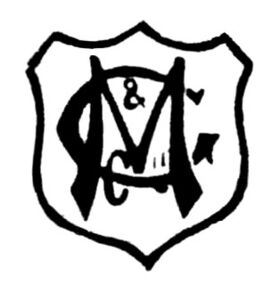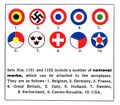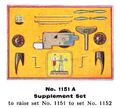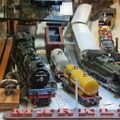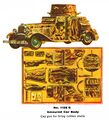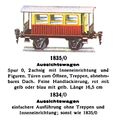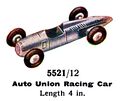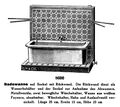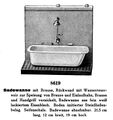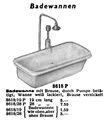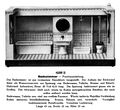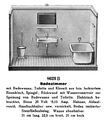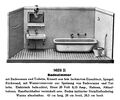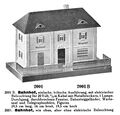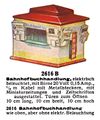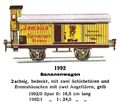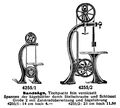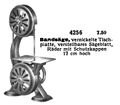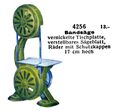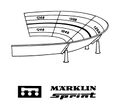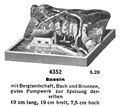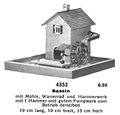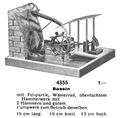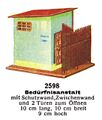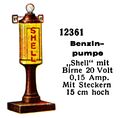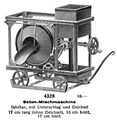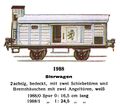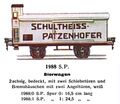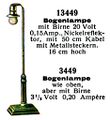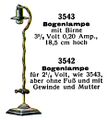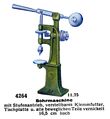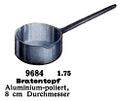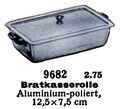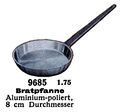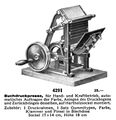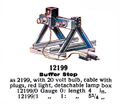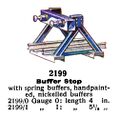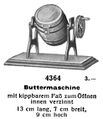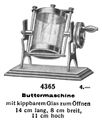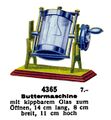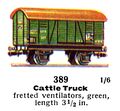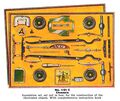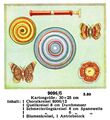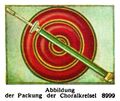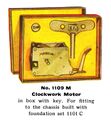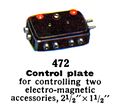Category:Märklin: Difference between revisions
(+logos) |
m (+category) |
||
| Line 36: | Line 36: | ||
{{MetCon}} | {{MetCon}} | ||
{{BLSupp}} | |||
Revision as of 02:00, 1 April 2014
| Toy Brands and Manufacturers |
|---|
Märklin |
Marklin catalogue front cover artwork [image info]
Marklin tinplate bridge, circa 1920 [image info]
The Marklin factory, image from the 1932 catalogue [image info]
The Märklin ( or Maerklin ) toymaking business, started in 1859 in the toy and craftmaking region of Württemburg as W. Märklin by Theodor Märklin, is one of the great toymaker marques.
In 1888 the company became Gebrüder Märklin ("Märklin Brothers"), and the company absorbed the toymaker Lutz in 1891.
Märklin's toys are often recognisable through their solid build quality, the common use of stylised proportions in the earlier toys, and a certain stylistic imaginative exhuberance, coupled with engineering excellence.
Later creations put more emphasis on literal precision and correct proportions, but the more distinctively toylike products produced between ~1895 and ~1914 are sometimes referred to as belonging to the "Golden Age" of Märklin.
Foundation
Theodor Friedrich Wilhelm Märklin (1817 - 1866) opened his metalworking workshop in Göppingen in 1759, the same year that he married Caroline. Caroline started working as a travelling sales rep for the workshop which initially had a sort of niche making toy kitchens for dolls. Caroline continued to run the business after her husband's death. Of their four children, the two sons, Eugen Märklin (1861 - 1947) and Charles Märklin took over and restructured the business in 1888 (after Caroline's second husband died), as Gebr. Märklin (Märklin Brothers).
The new business no longer just made toy kitchens and stoves, but expanded to produce just about every small type of metal toys or associated item that one could think of, helped by the takeover of Lutz.
Lutz
Ludwig Lutz (1820-1899) had founded a successful company making painted tin toys, including clockwork cars and toy trains, and although Lutz had groomed his two sons and daughter to take part in and run the business, the company now needed an overhaul and investment in new machinery, and selling out to the new Gebr Märklin company seemed opportune.
The same year that they took over Lutz (1891), Märklin exhibited a model railway at the Leipzig Spring Fair consisting of a locomotive running on a figure-eight track
Gauge
Although the new Märklin company went on to produce everything from enamelled toy fountains to scientific equipment, their main achievement is usually taken to be the introduction of the concept of standardised gauges for model railways. Where model trains had tended to be single items that were often floorbound (because the investment in making track to go with each model didn't seem worthwhile), Märklin recognised that if one was to build railway sets, it wasn't sensible to make new sets of track to go with each arbitrary-sized model train ... track had to be standardised, with subsequent trains designed to fit the existing track, rather than the track being designed to fit the trains.
Märklin's initial track size became Gauge 1 (Spur 1), and was joined by a range of larger and progressively larger-numbered track gauges, and a smaller gauge, gauge 0. These standard gauges promoted interoperability between different companies' products, and reduced the risk both for buyers purchasing a model railway, and for third-party companies supplying specialised accessories and components. For a small company whose expertise was track, or locomotives, or rolling stock, standardised gauges meant that they could sell into existing markets without having to invest in manufacturing entire model railway sets themselves, or having to depend on the strategy of any one external company. The standardised gauging system created an ecology of companies around each gauge, reassuring buyers that their investment wasn't dependent on a single company or product line, and reassuring smaller companies that these were stable markets to sell into.
References and links
- Gilles Herve, Charlotte Parry-Crooke, Märklin 1895-1914 (Ingram, 1983) ISBN 0907724035
Subcategories
This category has the following 42 subcategories, out of 42 total.
0
- Märklin 00-gauge (23 P, 58 F)
1
- Märklin gauge 1 (11 P, 234 F)
A
- Aeroplane Construction Sets (Märklin) (1 P, 9 F)
- Märklin Army Vehicles (32 F)
B
- Märklin for Bassett-Lowke (3 P, 6 F)
- Märklin Bathroom (11 F)
C
- Märklin catalogues (25 F)
G
- Märklin goods train rolling stock (25 P, 263 F)
- Märklin guns and artillery (1 P, 40 F)
H
- Hamo (empty)
J
- Josef Danilowatz (1877-1945) (6 F)
K
- Märklin Kitchen (1 P, 28 F)
L
- Märklin lamps and lights (6 P, 22 F)
M
- Marklin roadway (6 F)
- Marklin Sprint accessories (2 F)
- Marklin Sprint cars (16 F)
- Marklin Sprint sets (6 F)
- Marklin Sprint track (9 F)
- Minex construction sets (13 F)
- Märklin bridges (3 P, 18 F)
- Märklin miscellaneous (2 P, 12 F)
- Märklin Model Railways (display) (35 P, 31 F)
P
- Märklin passenger train rolling stock (16 P, 107 F)
R
S
- Märklin Spinners (50 F)
- Märklin Stations (3 P, 19 F)
- Märklin Steam (31 F)
V
- Märklin miniature vehicles (55 F)
W
- Märklin Working Models (66 F)
Pages in category ‘Märklin’
The following 108 pages are in this category, out of 108 total.
B
C
- Car No4 Pullman Carriage (Marklin gauge 1)
- Charles Dickens locomotive LNWR 955, 110V electric, gauge 1 (Märklin D-3021-Ch-D)
- Circus Lion in Cage (Märklin)
- CIWL coaches (Marklin)
- CIWL Sleeping Car (Märklin 346-3J)
- Cleopatra Pullman car (Marklin gauge 1)
- Cleopatra Pullman car (Marklin ~2890-0)
- Closed Goods Truck (Märklin 1997-0)
- Cock O’ The North locomotive LNER 2001 (Märklin L70-12920LNER)
- Container Wagon (Marklin 28581)
- Cooking range (Marklin)
- Covered Goods Wagon (Marklin 353 365+)
- Covered Junction Platform, arched, gauge 0 (Märklin 2078)
- Crane Truck, 10 Ton (Marklin 366)
D
- Der Adler 1835-1935 Centenary train set (Märklin AR12930-35-3)
- Deutsche Reichsbahn DR postal service carriage, H0 (Marklin 346-5)
- Double 'Fish-belly' Railway Bridge - Doppelfischbauchbrücke (Märklin 2503)
- DRG Berlin-Munchen passenger coach 19410, with interior fittings (Märklin 1941-G)
- DRG luggage coach (Marklin gauge 0)
E
F
G
- Garden Tea Party with table and four figures (Märklin 2678)
- Garden Tractor (Märklin Metallbaukästen)
- Goods Wagon, circa ~1902 (Märklin 1804)
- Gotthard Be 4/6 electric locomotive (Märklin S64-13020)
- Gotthard Be 4/6 electric locomotive, gauge 1 (Marklin HS-65-13021)
- Graf Zeppelin D-LZ130 airship (Marklin 11400 special edition)
- Guard's Van 605, circa 1902 (Märklin)
H
L
- LBSCR locomotive 22 (Marklin gauge 0)
- Lego-compatible railway truck, Bausteinwagen (Marklin 44734)
- Lego-compatible railway truck, LGB, Bausteinwagen (Marklin 94063)
- Leipzig Station - Kleiner Leipziger (Märklin 2037)
- Level Crossing, 00-gauge (Märklin)
- Level crossing, gauge 1, Gamages (Märklin 2822)
- Locomotive 89005 (Marklin 3000)
- Locomotive, green, 4-6-2 (Märklin HR 66-12920)
- Low-Level Bridge (Marklin 2065-1)
- Low-sided Open Goods Truck (Marklin 364)
- Luggage Van (Marklin 310)
- Luggage Van, DR (Marklin 344)
M
- Marklin Plus
- Meccano Clockwork Motor No2, black, 1912 (Märklin for Meccano Ltd)
- Meccano Clockwork Motor No2, silver, 1912 (Märklin for Meccano Ltd)
- Mercedes-Benz SSK constructor clockwork racing car (Marklin 1103)
- Merchant Taylors Schools-Class loco SR 910 (Märklin for Bassett-Lowke)
- Milk Transport Wagon, gauge 0 (Märklin 1777-0)
- Mitropa Dining Car - Speisewagen (Marklin 352)
- Mitropa Sleeping Car - Schlafwagen (Marklin 353)
- Märklin Metallbaukasten metal construction set No 1 (Märklin)
P
- Paris-Orleans steeple cab loco PO E1 (Marklin CL3021B)
- Passenger Wagon 2nd Class - Personenwagen, Goppingen (Marklin 4040)
- Petroleum Comp Tanker Wagon, circa ~1902 (Märklin 1812)
- Platform Bookstall Trolley, with newspapers (Märklin 2628)
- Platform Buffet Trolley, with food (Märklin 2627)
- Poultry Wagon - Kleintierwagen (Marklin 386)
R
S
- Shell Petrol Tanker Wagon, gauge 0 (Märklin 1854 S)
- Station electric lamp, repaint, green (Märklin 3448)
- Station Electric Lamps (Märklin 3448)
- Station Master, with hut and electric arm (Märklin 1St 469)
- Station with Signal Bell (Märklin 2650)
- Stephenson Tank Locomotive SR 329, gauge 0 (Märklin TK1020)
- Stephenson Tank Locomotive SR 329, gauge 1 (Märklin TK1021)
- Street Lamp (Märklin 3449)
- Street Lamp (Märklin 3550)
- Street Lamps with Ladders (Märklin 2838)
- Swiss 2B1 electric locomotive (Marklin CS66-12920)
- Swiss 2B1 electric locomotive (Marklin CS66-12921)
- Swiss 2C1 electric locomotive (Märklin HS66-12920)
T
- Talbot Gravel Wagon with side-chute (Märklin 1767)
- Talbot Hopper Wagon - Schotter-wagen (Marklin 367)
- Tank Locomotive TM800 (Marklin TM800)
- Tanker Wagon, BP, H0 (Marklin 314)
- Tanker Wagon, Shell (Marklin 314)
- Tanker Wagon, Standard, ESSO (Marklin 374)
- Timber Truck (Märklin 372)
- Train Indicator (Märklin 2644)
- Train Indicator 2 (Märklin 2644)
- Tunnel (Märklin)
- Two-Button Controller (Märklin 472)
Media in category ‘Märklin’
The following 200 files are in this category, out of 1,228 total.
(previous page) (next page)- 00-gauge layout, night, Märklin, Leipziger Messe 1939 (MarklinCat 1939).jpg 3,200 × 2,176; 5.72 MB
- Abfährtstander - Departures Board, Märklin 2649 (MarklinCat 1931).jpg 1,389 × 1,053; 524 KB
- Acid Truck, Märklin 1990 (MarklinCat 1936).jpg 1,566 × 1,078; 403 KB
- Aeroplane Construction Set, Märklin 1151 (MarklinCat 1936).jpg 2,107 × 2,839; 3.33 MB
- Aeroplane Construction Set, Märklin 1152 (MarklinCat 1936).jpg 2,405 × 2,907; 3.98 MB
- Aeroplane Construction Sets, markings (MarklinCat 1936).jpg 1,781 × 1,553; 818 KB
- Aeroplane Construction Sets, Märklin (MarklinCat 1936).jpg 1,475 × 2,000; 1.72 MB
- Aeroplane Construction Supplement Set 1151A (MarklinCat 1936).jpg 1,219 × 1,096; 757 KB
- Alfa Romeo Racing Car, Märklin 5521-14 (MarklinCat 1936).jpg 930 × 718; 241 KB
- Alfa-Romeo-Rennwagen - Racing Car, Märklin 5521-14 (MarklinCat 1939).jpg 948 × 604; 222 KB
- Area 30c.jpg 1,024 × 768; 477 KB
- Area 32.jpg 1,024 × 1,021; 524 KB
- Armoured Car Body, for Car Construction Set, Märklin 1108G (MarklinCat 1936).jpg 2,112 × 2,329; 2.29 MB
- Aussichtswagen - Panoramic View Carriage, Märklin M1824 (MarklinSFE 1900s).jpg 1,167 × 841; 530 KB
- Aussichtswagen - Viewing Car, Märklin 1834 1835 (MarklinCat 1931).jpg 1,468 × 1,502; 771 KB
- Auto Union Racing Car, Märklin 5521-12 (MarklinCat 1936).jpg 919 × 774; 230 KB
- Auto Union Racing Car, Märklin 5521-2 (MarklinCat 1936).jpg 974 × 761; 260 KB
- Auto-Union-Rennwagen - Racing Car, Märklin 5521-12 (MarklinCat 1939).jpg 909 × 622; 213 KB
- Auto-Union-Rennwagen - Racing Car, Märklin 5521-16 (MarklinCat 1939).jpg 1,160 × 844; 359 KB
- Auto-Union-Rennwagen - Racing Car, Märklin 5521-2 (MarklinCat 1939).jpg 982 × 691; 233 KB
- Auto-Union-Rennwagen - Racing Car, Märklin 5521-62 (MarklinCat 1939).jpg 1,064 × 687; 281 KB
- Automatic Dial Balance Scales, Märklin 2605 (MarklinCat 1936).jpg 1,207 × 858; 389 KB
- Automatic Ticket Machine, Märklin 2651 (MarklinCat 1936).jpg 886 × 712; 275 KB
- Automatische Schnellwage - Automatic Scales, Märklin 2605 (MarklinCat 1931).jpg 987 × 1,377; 441 KB
- Automobil - Limousine Car, clockwork, Märklin 5209 (MarklinCat 1931).jpg 2,751 × 1,866; 1.74 MB
- Badewanne - Bath, Märklin 8600 (MarklinCatx 1931).jpg 1,816 × 1,620; 1.04 MB
- Badewanne - Bath, Märklin 8618 (MarklinCatx 1931).jpg 943 × 761; 214 KB
- Badewanne - Bath, Märklin 8619 (MarklinCatx 1931).jpg 1,507 × 1,598; 814 KB
- Badewannen - Bath, Märklin 8618 (MarklinCat 1939).jpg 1,478 × 1,642; 470 KB
- Badezimmer - Bathroom, Märklin 8598-B (MarklinCatx 1931).jpg 1,601 × 2,043; 1.3 MB
- Badezimmer - Bathroom, Märklin 8599-B (MarklinCatx 1931).jpg 2,401 × 2,207; 2.11 MB
- Badezimmer - Bathroom, Märklin 8623-B (MarklinCatx 1931).jpg 1,535 × 1,754; 1.08 MB
- Badezimmer - Bathroom, Märklin 8624-B (MarklinCatx 1931).jpg 1,961 × 1,638; 1.29 MB
- Baggage Car - Gepackwägen, DR, Märklin 354 354B 354J 354JB (MarklinCat 1939).jpg 2,129 × 1,249; 874 KB
- Baggage Trolley, Märklin 2693 (MarklinCat 1936).jpg 690 × 956; 166 KB
- Baggermaschine - Bucket Excavator, Märklin 4318 4316 (MarklinCat 1932).jpg 1,254 × 1,857; 535 KB
- Baggermaschine - Bucket Excavator, Märklin 4319 4317 (MarklinCat 1932).jpg 1,403 × 1,991; 716 KB
- Baggerwerke - Excavator, Märklin 4316 (MarklinCat 1939).jpg 1,136 × 1,435; 468 KB
- Bahnhof - Station, Märklin 2001 (MarklinCat 1931).jpg 1,874 × 1,792; 1.03 MB
- Bahnhof - Station, Märklin 2001-F (MarklinCat 1931).jpg 2,154 × 1,623; 1.02 MB
- Bahnhof - Station, Märklin 2003 (MarklinCat 1931).jpg 3,000 × 1,185; 1.21 MB
- Bahnhof - Station, Märklin 2029 (MarklinCat 1931).jpg 2,162 × 1,778; 1.25 MB
- Bahnhof - Station, Märklin 2030 (MarklinCat 1931).jpg 2,200 × 1,666; 1.05 MB
- Bahnhof - Station, Märklin 2033 (MarklinCat 1931).jpg 3,000 × 1,479; 1.18 MB
- Bahnhofbuchhandlung - Station Newsagent, Märklin 2616 (MarklinCat 1931).jpg 1,200 × 1,445; 812 KB
- Bahnhofhalle - Leipzig Station Canopy, Märklin 2078 (MarklinCat 1931).jpg 3,000 × 1,414; 1.48 MB
- Bahnsteigbüfett - Railway Station Buffet, Märklin 2617 (MarklinCat 1931).jpg 1,098 × 1,465; 742 KB
- Bahnsteigsperre - Railway Station Barrier, Märklin 2632 (MarklinCat 1931).jpg 1,007 × 1,397; 477 KB
- Bahnsteigsperre - Railway Station Barrier, Märklin 2633 (MarklinCat 1931).jpg 1,696 × 1,359; 709 KB
- Balancier-Dampfmaschine, model, Märklin Minex (MarklinCat 1939).jpg 2,074 × 1,391; 977 KB
- Bananenwagen - Banana Wagon, Fyffes, Märklin 1682 (MarklinCat 1939).jpg 1,170 × 965; 633 KB
- Bananenwagen - Banana Wagon, Fyffes, Märklin 1792 (MarklinCat 1931).jpg 1,799 × 1,358; 1.1 MB
- Bananenwagen - Banana Wagon, Fyffes, Märklin 1792 (MarklinCat 1939).jpg 1,578 × 1,041; 707 KB
- Bananenwagen - Banana Wagon, Märklin 1992 (MarklinCat 1931).jpg 1,532 × 1,327; 821 KB
- Band Saw, model, Märklin Metallbaukasten 4F (MarklinCat 1936).jpg 924 × 1,182; 391 KB
- Bandsäge - Band Saw, Märklin 4255-1 4255-2 (MarklinCat 1932).jpg 1,830 × 1,644; 658 KB
- Bandsäge - Band Saw, Märklin 4256 (MarklinCat 1932).jpg 1,412 × 1,234; 313 KB
- Bandsäge - Band Saw, Märklin 4256 (MarklinCat 1939).jpg 1,341 × 1,243; 413 KB
- Banked Curve Supports, Marklin Sprint 1546 (Marklin 1971).jpg 1,548 × 1,153; 607 KB
- Banked Curves 45-degrees, Marklin Sprint 1248 1268 (Marklin 1971).jpg 1,543 × 1,234; 592 KB
- Banked Curves, Marklin Sprint (Marklin 1971).jpg 1,631 × 1,457; 268 KB
- Barrier, Märklin 2219 2219-B (MarklinCat 1936).jpg 1,395 × 995; 179 KB
- Barrier, remote controlled, Märklin 13731 (MarklinCat 1936).jpg 1,837 × 896; 500 KB
- Barrière avec poteau Attention, Märklin 2219 (MärklinCatFr ~1921).jpg 1,927 × 1,061; 583 KB
- Bass Closed Goods Waggon, Märklin E1988-0 (MarklinCRH ~1925).jpg 1,433 × 1,066; 507 KB
- Bassett-Lowke, King George V 6000, gauge 0 (BL-MR 1937-11).jpg 1,541 × 2,130; 510 KB
- Bassett-Lowke, Merchant Taylors 910, gauge 0 (BL-MR 1937-11).jpg 1,526 × 2,226; 610 KB
- Bassin - Mountain Stream, Märklin 4352 (MarklinCat 1932).jpg 1,437 × 1,284; 570 KB
- Bassin - Water Mill, Märklin 4353 (MarklinCat 1932).jpg 1,529 × 1,461; 554 KB
- Bassin - Water Wheel, Märklin 4355 (MarklinCat 1932).jpg 1,553 × 1,525; 661 KB
- Bedeckter Güterwagen - Closed Goods Van, Märklin 1791 (MarklinCat 1939).jpg 1,562 × 1,021; 692 KB
- Bedeckter Güterwagen - Closed Goods Wagon, Märklin 1781 (MarklinCat 1939).jpg 1,418 × 1,069; 686 KB
- Bedeckter Güterwagen - Closed Goods Wagon, Märklin 1856 (MarklinCat 1939).jpg 1,857 × 1,074; 768 KB
- Bedeckter Güterwagen - Goods Van, Märklin 1781 (MarklinCat 1931).jpg 1,686 × 1,359; 1 MB
- Bedeckter Güterwagen - Goods Van, Märklin 1791 (MarklinCat 1931).jpg 1,788 × 1,427; 1.1 MB
- Bedeckter Güterwagen - Goods Van, with lights, Märklin 1791-B-0 (MarklinCat 1931).jpg 1,794 × 1,357; 1.09 MB
- Bedürfnisanstalt - Public Toilet, Märklin 2601 (MarklinCat 1931).jpg 1,075 × 1,380; 679 KB
- Bedürfnisanstalt - Public Toilets with screen, Märklin 2598 (MarklinCat 1931).jpg 1,026 × 1,204; 525 KB
- Bedürfnisanstalt - Public Urinals, Märklin 2596 (MarklinCat 1931).jpg 1,332 × 747; 318 KB
- Benzinpumpe - Petrol Pump, Shell, Märklin 12361 (MarklinCat 1931).jpg 876 × 859; 204 KB
- Beton-Mischmaschine - Concrete Mixer, Märklin 4328 (MarklinCat 1932).jpg 1,621 × 1,662; 769 KB
- Better Toys, Märklin (1930).jpg 1,600 × 800; 138 KB
- Bierwagen - Beer Wagon, Lowenbrau, Märklin 1968-N (MarklinCat 1931).jpg 1,255 × 992; 533 KB
- Bierwagen - Beer Wagon, Märklin 1988 (MarklinCat 1931).jpg 1,558 × 1,382; 834 KB
- Bierwagen - Beer Wagon, Schultheiss-Patzenhofer, Märklin 1988-SP (MarklinCat 1931).jpg 1,558 × 1,345; 798 KB
- Blauer Vogel - Bluebird Speed Record Car, Märklin 5521-18 (MarklinCat 1939).jpg 1,174 × 667; 319 KB
- Bluebird Record-Breaking Car, Märklin 5521-18 (MarklinCat 1936).jpg 1,185 × 822; 321 KB
- Bogenlampe - Street Lamp with four bulbs, Märklin 13453-4 (MarklinCat 1931).jpg 1,025 × 1,567; 341 KB
- Bogenlampe - Street Lamp with two bulbs, Märklin 13453-2 (MarklinCat 1931).jpg 1,027 × 1,481; 294 KB
- Bogenlampe - Street Lamp, Märklin 3499 (MarklinCat 1931).jpg 936 × 1,021; 282 KB
- Bogenlampe - Street Lamp, Märklin 3542 (MarklinCat 1931).jpg 933 × 1,035; 257 KB
- Bogenlampe - Street Lamp, Märklin 3550 (MarklinCat 1931).jpg 964 × 1,393; 320 KB
- Bogenlampe - Street Lamp, Märklin 3551 (MarklinCat 1931).jpg 1,137 × 1,493; 398 KB
- Bogenlampe - Street Lamp, Märklin 3553 (MarklinCat 1931).jpg 1,004 × 1,533; 386 KB
- Bohrmaschine - Drill Station, Märklin 4264 (MarklinCat 1939).jpg 1,393 × 1,513; 423 KB
- Bohrmaschine - Drill, Märklin 4263 (MarklinCat 1932).jpg 1,977 × 1,423; 483 KB
- Bohrmaschine - Drill, Märklin 4264 (MarklinCat 1932).jpg 1,584 × 1,279; 328 KB
- Bonds, Märklin sale (MM 1935-06).jpg 743 × 1,251; 171 KB
- Bottle Elevator, model, Märklin Metallbaukasten 101-1 (MarklinCat 1936).jpg 956 × 1,721; 775 KB
- Boys with Flying Boat, promotional artwork, Märklin Metallbaukasten (MarklinCat 1936).jpg 2,358 × 1,345; 1.71 MB
- Bracket Signal, Märklin 2819-0 (MarklinCRH ~1925).jpg 859 × 1,092; 196 KB
- Bracket, black (Märklin Metall).jpg 844 × 501; 133 KB
- Brake Van, LMS LNER, Märklin 2885-0 (MarklinCRH ~1925).jpg 1,340 × 1,065; 479 KB
- Brake Van, Märklin 1790 (MarklinCat 1936).jpg 1,505 × 1,119; 744 KB
- Braunkohlenstaubwagen - Brown Coal Dust Wagon, Märklin 1775 (MarklinCat 1939).jpg 1,538 × 1,092; 737 KB
- Bretterwagen - Timber Wagon, Märklin 1966 (MarklinCat 1931).jpg 1,453 × 954; 592 KB
- Bretterwagen - Timber Wagon, Märklin 1966 (MarklinCat 1939).jpg 1,353 × 928; 590 KB
- Bridge, 00, Märklin 462 (MarklinCat 1936).jpg 1,395 × 864; 213 KB
- Brunnen - Water Pump and Trough, Märklin 4359 (MarklinCat 1932).jpg 1,071 × 1,465; 342 KB
- Brunnen - Water Pump and Trough, Märklin 4360 (MarklinCat 1932).jpg 1,114 × 1,609; 444 KB
- Buchdruckpresse - Book Printing Press, Märklin 4291 (MarklinCat 1932).jpg 1,724 × 1,779; 803 KB
- Buffer Stop, concrete style, Märklin 2203 12203 (MarklinCat 1936).jpg 999 × 1,382; 199 KB
- Buffer Stop, Märklin 12199 (MarklinCat 1936).jpg 1,199 × 1,046; 157 KB
- Buffer Stop, Märklin 2199 (MarklinCat 1936).jpg 1,003 × 979; 135 KB
- Buffers, Märklin 2200-0 (MarklinCRH ~1925).jpg 515 × 623; 110 KB
- Buttermaschine - Butter Churn, Märklin 4364 (MarklinCat 1932).jpg 980 × 1,136; 286 KB
- Buttermaschine - Butter Churn, Märklin 4365 (MarklinCat 1932).jpg 1,030 × 1,215; 361 KB
- Buttermaschine - Butter Churn, Märklin 4365 (MarklinCat 1939).jpg 1,053 × 1,143; 404 KB
- Cabriolet Car (Adler), Märklin 5521-51 (MarklinCat 1939).jpg 1,040 × 754; 351 KB
- Cabriolet Car (Horch), Märklin 5521-8-L (MarklinCat 1939).jpg 1,217 × 848; 437 KB
- Cabriolet Car, clockwork, Märklin 5522-4 (MarklinCat 1939).jpg 936 × 771; 266 KB
- Cabriolet Car, Märklin 5521-4 (MarklinCat 1939).jpg 974 × 705; 317 KB
- Car Construction Sets, Märklin (MarklinCat 1936).jpg 3,000 × 1,559; 2.09 MB
- Car Presentation Set, Märklin 5521 LG-4 (MarklinCat 1936).jpg 2,039 × 1,238; 1.24 MB
- Car Presentation Set, Märklin 5521 RG-4 (MarklinCat 1936).jpg 2,022 × 1,224; 1.2 MB
- Cars and trains, Marklin artwork, Josef Danilowatz (MarklinCat 1936).jpg 2,331 × 1,190; 1.74 MB
- Cattle Truck, 00 gauge, Märklin 389 (Marklin00CatGB 1937).jpg 888 × 825; 334 KB
- Cattle Truck, Märklin E1989-0 (MarklinCRH ~1925).jpg 1,388 × 965; 445 KB
- Chaparral 2E Sports Car, Marklin Sprint 1315 (Marklin 1973).jpg 1,900 × 900; 697 KB
- Charles Dickens locomotive 955, edited, Bassett-Lowke 1904 catalogue.jpg 2,577 × 1,798; 537 KB
- Charles Dickens locomotive LNWR 955, 110V (Märklin D 3021).jpg 3,200 × 1,847; 3.08 MB
- Chassis for Car Construction Set, Märklin 1101C (MarklinCat 1936).jpg 4,022 × 1,632; 3.17 MB
- Chassis, for Car Construction Set, Märklin 1101C (MarklinCat 1936).jpg 2,451 × 2,053; 3.07 MB
- Chemins de Fer Electriques - Electric Railways, Märklin (MärklinCatFr ~1921).jpg 3,200 × 2,537; 1.82 MB
- Chicane, Marklin Sprint 1216 (Marklin 1971).jpg 1,605 × 809; 419 KB
- Choralkreisel - Humming Top with selection, Märklin 9096-12 (MarklinCat 1932).jpg 2,500 × 1,348; 1.77 MB
- Choralkreisel - Humming Top with selection, Märklin 9096-6 (MarklinCat 1932).jpg 1,580 × 1,729; 1.44 MB
- Choralkreisel - Humming Top, Märklin 8996-12 (MarklinCat 1932).jpg 957 × 1,642; 717 KB
- Choralkreisel - Humming Top, Märklin 8996-12 (MarklinCat 1939).jpg 1,460 × 754; 515 KB
- Choralkreisel - Humming Top, Märklin 8999-12 8999-15 (MarklinCat 1932).jpg 1,366 × 2,460; 661 KB
- Choralkreisel - Humming Top, packing, Märklin 8999 (MarklinCat 1932).jpg 1,151 × 970; 673 KB
- Choralkreisel - Singing or Humming Tops (MarklinCat 1932).jpg 1,598 × 1,180; 437 KB
- Circus Cashier Car, Märklin 1983-C (MarklinCat 1936).jpg 953 × 719; 349 KB
- Circus Lion Cage Car, Märklin 1983-T (MarklinCat 1936).jpg 971 × 755; 351 KB
- CIWL Dining Car - Speisewagen, Marklin 352J (MärklinCat 1939).jpg 2,033 × 670; 690 KB
- CIWL railway carriage, gauge 0 (Marklin).jpg 1,200 × 800; 558 KB
- CIWL Schlafwagen - Sleeping Car, Märklin 1747 (MarklinCat 1931).jpg 1,805 × 1,141; 945 KB
- CIWL Schlafwagen - Sleeping Car, Märklin 1747 1747-G (MarklinCat 1936).jpg 2,013 × 934; 927 KB
- CIWL Schlafwagen - Sleeping Car, Märklin 1757 (MarklinCat 1939).jpg 1,630 × 990; 622 KB
- CIWL Speisewagen - Dining Car, Märklin 1746 (MarklinCat 1931).jpg 1,791 × 1,135; 914 KB
- CIWL Speisewagen - Dining Car, Märklin 1746 1746-G (MarklinCat 1936).jpg 1,827 × 936; 899 KB
- CIWL Speisewagen - Dining Car, Märklin 1756 (MarklinCat 1939).jpg 1,616 × 960; 601 KB
- Clock Accessory Set, electric, Märklin Metallbaukasten 103 (MarklinCat 1936).jpg 1,243 × 1,642; 1 MB
- Clock Accessory Set, Märklin Metallbaukasten 102 (MarklinCat 1936).jpg 1,221 × 1,690; 1.15 MB
- Clockwork Motor, for Aeroplane Construction Sets, Märklin 1159 (MarklinCat 1936).jpg 1,092 × 1,108; 476 KB
- Clockwork Motor, for Car Construction Set, Märklin 1109M (MarklinCat 1936).jpg 1,245 × 1,349; 878 KB
- Clockwork Motor, Märklin Metallbaukasten 201 202 (MarklinCat 1936).jpg 1,319 × 1,621; 1.03 MB
- Clockwork Tractor, Märklin 1088 (MarklinCat 1936).jpg 1,250 × 1,123; 692 KB
- Clockwork Tractor, Märklin 1088-00 (MarklinCat 1936).jpg 830 × 841; 325 KB
- Clockwork Trolley, Märklin 5236 M (MarklinCat 1936).jpg 1,655 × 786; 510 KB
- Closed Goods Truck, 00 gauge, Märklin 381 (Marklin00CatGB 1937).jpg 870 × 770; 317 KB
- Closed Goods Truck, Fyffes Bananas, Jamaica, Märklin 1792 (MarklinCat 1936).jpg 1,540 × 1,122; 875 KB
- Closed Goods Truck, Märklin 2882-0 (MarklinCRH ~1925).jpg 1,203 × 1,106; 463 KB
- Closed Goods Truck, Staatl Mineralbrunnen Fachingen, Märklin 1997 (MarklinCat 1936).jpg 1,527 × 1,155; 455 KB
- Closed Goods Truck,with sliding doors, Märklin 1796 (MarklinCat 1936).jpg 1,428 × 1,146; 808 KB
- Closed Goods Van, Märklin E1929-0 (MarklinCRH ~1925).jpg 1,469 × 1,105; 558 KB
- Coal Truck, LMS LNER, Märklin 1920-0 (MarklinCRH ~1925).jpg 1,359 × 923; 327 KB
- Coal Truck, Märklin E1982-0 (MarklinCRH ~1925).jpg 1,443 × 955; 398 KB
- Cock O' The North locomotive (Märklin).jpg 640 × 480; 178 KB
- Cock O' The North Locomotive LNER 2001, Märklin L70-12920 (MarklinCat 1936).jpg 3,634 × 1,327; 2.09 MB
- Collection of black and brass parts, circa 1930s (Märklin Metall).jpg 3,000 × 2,503; 1.9 MB
- Commodore Vanderbilt streamlined steam locomotive (Märklin catalogue).jpg 1,423 × 411; 77 KB
- Control Plate with two buttons (Märklin 472).jpg 1,200 × 768; 374 KB
- Control Plate with two buttons, Märklin 472 (MarklinCat 1936).jpg 777 × 713; 83 KB
- Convertible Steam Motor, Märklin Metallbaukasten 401 402 (MarklinCat 1936).jpg 1,299 × 1,353; 917 KB
- Cooking Stove, electric, Märklin El-9602-4 (MarklinCat 1936).jpg 1,889 × 1,047; 670 KB
- Cooking Stove, electric, Märklin El-9602-4B (MarklinCat 1936).jpg 1,686 × 1,070; 703 KB
- Cooking Stove, electric, Märklin El-9622-3 El-9622-4 (MarklinCat 1936).jpg 2,450 × 1,639; 1.25 MB
- Cooking Stove, electric, Märklin El-9623-5 (MarklinCat 1936).jpg 1,941 × 2,673; 1.75 MB
- Cooking Stove, electric, Märklin El-9632-3 (MarklinCat 1936).jpg 1,691 × 1,876; 1.24 MB
- Cooking Stove, electric, Märklin El-9632-4 El-9632-5 (MarklinCat 1936).jpg 2,097 × 2,202; 1.71 MB
- Cooking Stove, electric, Märklin El-9672-3 (MarklinCat 1936).jpg 1,405 × 1,396; 814 KB
- Cooking Stove, electric, Märklin El-9673-3 (MarklinCat 1936).jpg 1,438 × 1,508; 1,016 KB
- Cooking Stove, spirit-fired, Märklin 9612-0 9612-1 9612-2 (MarklinCat 1936).jpg 2,132 × 1,278; 870 KB
- Cooking Stove, spirit-fired, Märklin 9622-3 9622-4 (MarklinCat 1936).jpg 2,178 × 1,373; 896 KB
- Cooking Stove, spirit-fired, Märklin 9623-5 (MarklinCat 1936).jpg 2,464 × 1,975; 1.25 MB
- Cooking Stove, spirit-fired, Märklin 9632-1 9632-2 (MarklinCat 1936).jpg 1,475 × 1,816; 1.1 MB
- Cooking Stove, spirit-fired, Märklin 9702-0W 9702-1W 9702-2W (MarklinCat 1936).jpg 1,139 × 1,331; 689 KB
